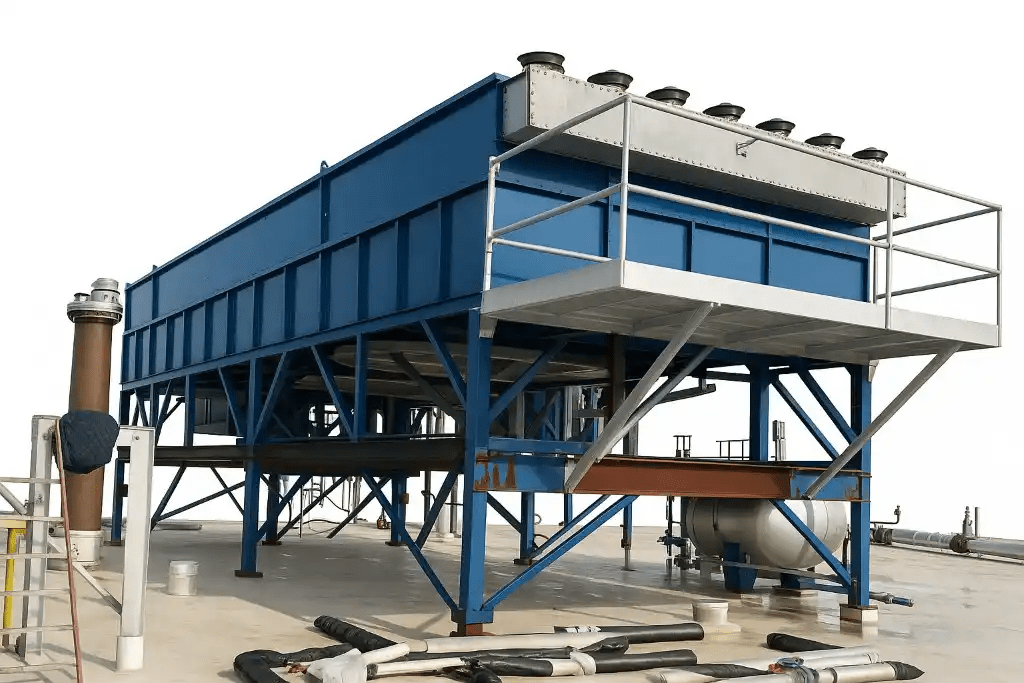Effect of Ambient Temperature on Air-Cooled Heat Exchanger (ACHE) Performance
Ambient temperature significantly impacts the thermal performance, efficiency, and operational reliability of air-cooled heat exchangers. Here’s a detailed analysis:
1. Fundamental Thermodynamic Impact
A. Approach Temperature Limitation
- Definition: Difference between outlet process fluid temperature and ambient air temperature
- Key Relationship:
math
Q = UAΔT_{LMTD}
Where ΔT decreases as ambient temperature rises
B. Performance Degradation
| Ambient Temp (°C) | Capacity Loss (%) |
| 25 (Design) | 0% |
| 30 | 5-8% |
| 35 | 12-18% |
| 40 | 20-30% |
2. Critical Effects on Operation
A. Heat Transfer Reduction
- 10°C ambient increase → ~15-25% capacity reduction
- Exponential effect at higher temperatures (non-linear relationship)
B. Fan Law Implications
- Compensation attempt: Increasing airflow via fan speed
- 10% higher velocity → 33% more fan power (P ∝ V³)
- Practical limit: Max 3.5-4 m/s face velocity before excessive ΔP
C. Process Side Consequences
- Higher process outlet temperatures
- Potential viscosity changes in cooled fluids
- Possible vapor pressure issues
3. Design Mitigation Strategies
A. Temperature-Dependent Design
| Design Parameter | Hot Climate Adaptation |
| Surface Area | +20-30% oversizing |
| Fin Type | High-efficiency louvered fins |
| Fan Control | VFD with temp-based logic |
B. Hybrid Cooling Options
- Adiabatic Pre-cooling
- Water spray systems (5-8°C air temp reduction)
- Consumes 1-3% of water used by wet cooling towers
- Mist/Fog Systems
- Micro-droplet evaporation cooling
- <0.5% water consumption vs. wet cooling
4. Operational Adjustments
A. Temperature Response Matrix
| Ambient Range | Recommended Action |
| <Design Temp | Reduce fan speed (energy savings) |
| Design+5°C | Max continuous fan speed |
| Design+10°C | Activate auxiliary fans/sprays |
| >Design+15°C | Process throughput reduction |
B. Smart Control Systems
- Real-time optimization algorithms considering:
- Ambient temperature
- Humidity
- Process criticality
- Electricity costs
5. Extreme Weather Considerations
A. Heat Wave Contingencies
- Temporary shading structures
- Nocturnal operation boost
- Emergency water spray activation
B. Cold Climate Effects
- Below 0°C: Risk of condensate freezing
- Below -20°C: Material brittleness concerns
- Solutions:
- Anti-icing controls
- Glycol mixtures
- Recirculation systems
6. Industry-Specific Impacts
| Industry | Critical Temperature Threshold | Typical Mitigation |
| Power Gen | 35°C wet bulb | Turbine load shedding |
| Petrochem | 40°C dry bulb | Feed rate reduction |
| Data Centres | 25°C intake | Coolant temp adjustment |
| LNG Plants | 30°C ambient | Storage pressure management |
7. Economic Consequences
- 1°C above design → 0.5-1.2% increased OPEX
- 5°C heat wave → Potential 15-25% production loss
- Undersized units may require 2-3x more maintenance
Conclusion
Ambient temperature is the dominant external factor affecting ACHE performance, with exponential impacts above design conditions. Modern solutions combine:
- Climate-adaptive designs (oversizing, smart controls)
- Hybrid cooling when water is limited
- Operational flexibility for extreme conditions
For your specific application, would you like assistance with:
- Climate-specific performance modelling?
- Retrofit options for existing units?
Emergency cooling contingency plans?
